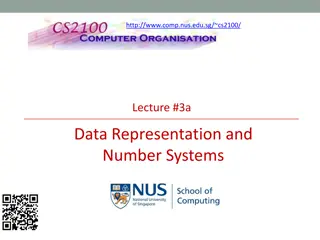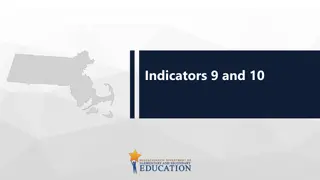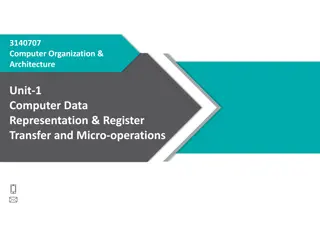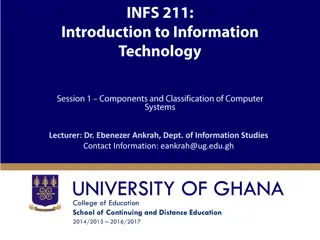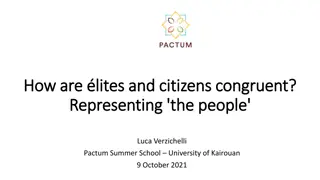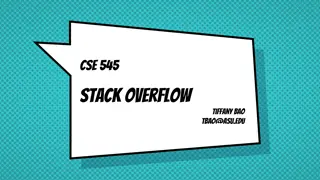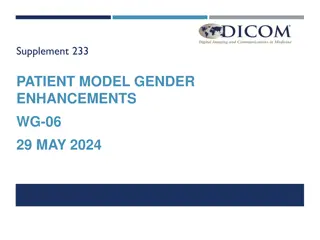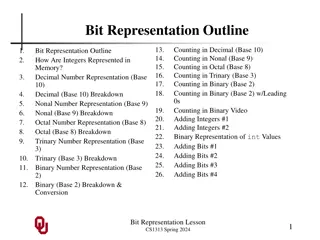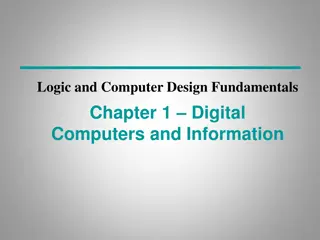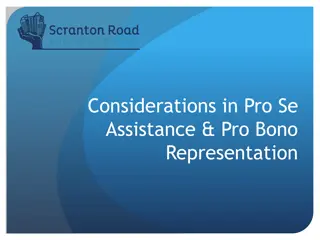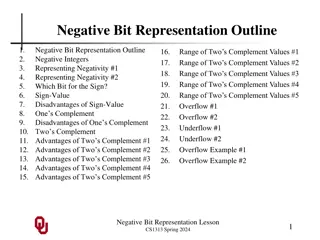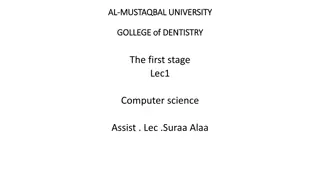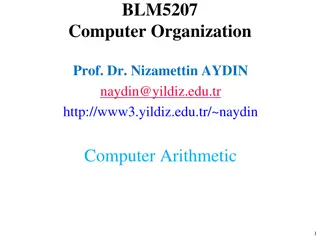Understanding Data Representation on Computer Systems
Explore how data is converted into binary forms in computer systems, the difference between data and information, binary coding schemes, and the elements of the data hierarchy. Learn about binary digits, bites, bytes, and the essential topics covered in this educational session. Recommended reading materials for further understanding are also provided.
Download Presentation

Please find below an Image/Link to download the presentation.
The content on the website is provided AS IS for your information and personal use only. It may not be sold, licensed, or shared on other websites without obtaining consent from the author. Download presentation by click this link. If you encounter any issues during the download, it is possible that the publisher has removed the file from their server.
E N D
Presentation Transcript
Data Representation on a Computer System Lecturer: Dr. Ebenezer Ankrah, Dept. of Information Studies Contact Information: eankrah@ug.edu.gh College of Education School of Continuing and Distance Education 2014/2015 2016/2017
Session Overview Unlike humans, computer systems work exclusively with numbers (binary system) to process data into information. Computer systems need to work in a language they understand. However, the question is how does the computer convert data into binary system? This session seeks discuss how data is represented in the computer system. At the end of the session, the student will Understand the difference between data and information Understand how data is converted to information Understand the binary coding schemes Be able to covert data into binary forms. Be able to differentiate between the various elements in the data hierarchy Slide 2
Session Outline The key topics to be covered in the session are as follows: Binary Digits Bites and Bytes Binary Coding Schemes Data Hierarchy Slide 3
Reading List Lucas, H. C. (1997). Information Technology for Management (6th ed.). R. R. Donnelly & Sons Company. (Chapter 6) Williams, B. K., & Sawyer, S. C. (2014). Using Information Technology: A practical introduction to computers and communications (11th ed.). McGraw-Hill Education. (Chapter 4) Slide 4
Topic One BINARY DIGITS Slide 5
Binary Digits Data representation on a computer system uses a simple on or off system. This is usually called a binary system.A computer is structured in such a way that it operates with devices having only two states: electric switches which are open or closed; electrical pulses high or not high; or magnetized elements having one of two directions or polarities. These two states are represented by 0 or 1 and are referred to as BINARY DIGITS or BITS. Internally, the microprocessor recognizes only these two symbols. Documents, photographs, drawings, recordings of sound or video have to be converted into this 0/1 data before IT can handle them. This conversion process is known as digitization (i.e. converting into the digits 0 and 1). Slide 6
Binary Digits Digitized information can be numbers, text, images, audio or video. Digitization is the key to making use of information technology. Once information has been digitized it can be subjected to a wide variety of manipulations. If information is not digitized, it cannot be handled by IT. The binary system means that the individual storage unit of a computer consists of a simple on or off circuit that is used to represent all types of data on a computer system no matter how complex it may seem Slide 7
Topic Two BITS AND BYTES Slide 8
Bits and Bytes BITS The numbers 1 and 0 are used to express the two states on or off respectively. Any piece of data or instruction must be coded in these symbols before processing can be done. Each 1 or 0 in the binary system is a bit. A bitis thus a binary digit of either 0 or 1. A bit is the smallest unit in which data can be represented on a computer. The size of a bit is very small. It is of a character. Slide 9
Bits and Bytes BYTE A byte is a group of eight bits and is thus equivalent to a character that can either be a letter, a number or another symbol. Since a byte has eight bits, there are 28, or 256, different combinations of (ones) 1s and zeros (0s), which is sufficient to cover numeric digits, upper and lower case alphabets, punctuation marks and other symbols. Slide 10
Bits and Bytes The capacity of computer memory (primary and secondary) is determined by the number of bytes it can hold. Capacity of bytes is usually calculated in kilobytes (Kb). In this case a kilobyte refers to (1 kilobyte =210 (1024) bytes. Even though it is customary to assume a kilo being equivalent to 1000, it is different in the case and actually equates 1024 bytes. A megabyte (Mb) is equivalent to 220 i. e. (1024x1024) bytes Slide 11
Bits and Bytes Gigabyte (Gb) i.e. (1gigabyte = 230 (1048576x1048576) byte) Terabyte (Tb) which is about one trillion bytes. kilobytes (Kb) = 210 (1024) bytes (about 1,000 bytes) megabyte (Mb) = 220 (1024x1024) bytes (about 1,000,000 bytes) gigabyte (Gb) (1gigabyte = 230 (1048576x1048576) bytes (about 1,000,000,000 bytes) Slide 12
Topic Three BINARY CODING SCHEMES Slide 13
Binary coding schemes Data and instructions are represented electronically with a binary numbering system. ASCII, EBCDIC, and Unicode are binary Coding schemes. The decimal system that we are all familiar with has 10 digits (0, 1, 2, 3, 4, 5, 6, 7, 8, 9). Thebinary system, however, consists of only two digits - 0 and 1. Each 0 or 1 is called a bit-short or binary digit. In the systemunit, the 0 can be represented by electricity being off and the 1 by electricity being on. Slide 14
Binary coding schemes In order to represent numbers, letters, and special character, bits are combined intogroups of eight bits called bytes. Each byte typically represents one character. The characters represented as 0s and 1s ( off and on electrical states) in the computer make use of binary coding schemes. Two of the most popular binary coding schemes use eight bits or one byte. These two coding schemes are ASCII and EBCDIC. A recently developed code, Unicode, uses sixteen bits. Slide 15
Binary coding schemes ASCII,pronounced as-key, stands for American Standard Code for Information Interchange. This is the most widely used binary code for microcomputers. For example, the number 3 is represented in ASCII code as 0011 0011. When you press a key on the keyboard, a character is automatically converted into a series of electronic pulses that the system can recognise. For example, pressing the number 3 on a keyboard causes an electronic signal to be sent to the microcomputer's system unit where it is converted to the ASCII code of 0011 0011. Slide 16
Binary coding schemes Character A Q + / 0 9 ASCII 0100 0001 0101 0001 0010 1011 0010 1111 0011 0000 0011 1001 Slide 17
Binary coding schemes EBCDIC,pronounced eb-see-dick, stands for Extended Binary Coded Decimal Interchange Code. It was developed by IBM and is used primarily for large computers. For example, the number 3 is represented in EBCDIC code as 1111 0011. Unicode is a 16-bit code designed to support international languages like Chinese and Japanese. These languages have too many characters to be represented by the eight-bit ASCII and EBCDIC codes. Slide 18
Binary coding schemes Coding schemes are particularly important to computer specialists to track down errors and other types of problems. There are several reasons, one of the most important is that data created by one computer system using one coding scheme cannot be directly accessed and used by another computer system using a different coding scheme. Generally, this is not a problem if both computers are microcomputers since both would most likely use ASCIIcode. Slide 19
Binary coding schemes However, problems occur when data is shared between microcomputers and larger computers that use EBCDIC code. The data must be translated from one coding scheme to the other before processing can begin. Fortunately, special Conversion programs are available to help with this translation. Slide 20
Topic Four DATA HIERARCHY Slide 21
Data hierarchy A bit represents the smallest unit of data a computer can handle. A group of bits is called a BYTE and represents a single character, which can be a letter, number or other symbol. A grouping of characters is called a FIELD. Field is an item of data about an entity. Terms such as attribute or data element are sometimes used to represent the same thing as a field. An entity is any person, place, event or thing about which data is held. Slide 22
Data hierarchy Record is a grouping of related data elements that represents one specific entity. A record forms a single entry in a file or database. Each record consists of several fields, and shares field names in common with the other records. File is a collection of related records. Database is a well-defined and managed collection of data. It may consist of a number of related files, for example student, course, tutor, etc. Slide 23
Data hierarchy Bit Byte Field The data hierarchy Record File Database Slide 24
References French, C. S. (2001). Data processing and information technology (10th ed.). London, Continuum: Sage Publications Ltd. Hutchinson, S. E., & Sawyer, S. C. (2000). Computers, communication and information: A user s introduction (7th ed.). Boston: Irwin McGraw-Hill. O Leary, T. J. (2004). Computing today. Boston: McGraw Hill. O Leary, T. J., & O Leary, L. I. (2005). Computing Essentials. Boston: McGraw Hill. Thompson, R. L., & Cats-Bail, W. L. (2003). Information technology and management (2nd ed.). Boston: Irwin McGraw- Hill. Williams, et al (2003). Using information technology: a practical introduction of computers and communications. Boston: McGraw-Hill. Slide 25










